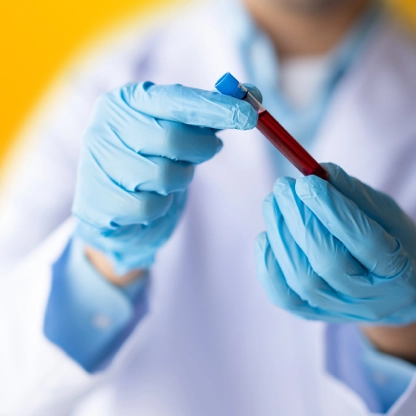
Article summary
Topic
Doctors have a broad array of diagnostic tools useful in liver disorders – even if they give rather uncharacteristic symptoms. They may conduct a traditional interview and perform a palpation examination (applying touch and pressure) and may order blood and serum analyses, imaging examinations or a biopsy.1
Medical interview and physical examination
A doctor who suspects a liver disease determines the diagnosis on the basis of an interview – obtaining information about past disorders, received medicines and supplements, quantities of consumed alcohol. Many persons with a diseased liver do not experience any symptoms or their symptoms are rather uncharacteristic. When conducting the interview, your doctor may ask you about such symptoms as:1,2
Feeling tired and weak
Appetite loss
Nausea
Abdominal pain
Itching of your skin
Your doctor will check if you do not have jaundice – yellow-coloured skin and sclera (the white part of your eye), if your stools is pale, white or tarry black. During the physical examination, your doctor may initially evaluate the size of your liver, and order an ultrasound examination to confirm it.1
Laboratory tests in liver diseases
The useful diagnostic tests are:1
- peripheral blood count,
- erythrocyte sedimentation rate and CRP – inflammation markers,
- levels of aminotransferases – AlAT, AspAT,
- cholestasis indicators – ALP, GGTP, bilirubin,
- lipid levels,
- immune tests for viral infections (hepatitis B and C, infectious mononucleosis, CMV).
Additional, more targeted diagnostic tests may include:
- the presence of antibodies typical for autoimmune disorders,
- evaluation of bile duct patency – endoscopic retrograde cholangiopancreatography (ERCP), cholangio-MRI,
- assessment of heart function – an echocardiographic examination,
- liver biopsy.
The basis of biochemical diagnostic work-up is testing blood plasma markers that are used for the assessment and monitoring of liver diseases. When analysing the results of laboratory tests, the doctor checks not only the absolute values but also their relations. Elevated levels of alanine aminotransferase (ALT, AlAT) and aspartate aminotransferase (AST, AspAT) may suggest an injury to hepatic cells. Gamma-glutamyl transferase (GTP, GGTP) and alkaline phosphatase (ALP) are in turn sensitive indicators of cholestasis; their elevated levels may also reflect alcohol abuse. On the other hand, a decreased level of albumins may indicate decreased ability of the liver to synthesise proteins.3
For more information about AspAT and AlAT, read more there
Accelerate liver regeneration with Phospholipids (Essentiale® Forte P)
Many people with liver disease experience little or no symtoms
Imaging examinations in liver diseases
The ultrasound scan (ultrasonography) is one of the basic methods of imaging examinations of the liver. It enables evaluation of the following parameters:4
- liver dimensions,
- homogeneity of structure of the liver parenchyma,
- the presence of focal lesions (tumours, cysts).
Doppler ultrasound can be used to additionally visualise flows in blood vessels.
A fairly new examination is elastography that uses ultrasound to assess elasticity of the liver tissue that is decreased in the case of hepatic fibrosis and cirrhosis.5
Invasive liver examinations – biopsy and laparoscopy
In some cases, biopsy is necessary to determine the diagnosis, assess the disease stage or take a decision about the therapeutic management; biopsy means collecting with a needle a small sample of the liver tissue that is subsequently assessed under a microscope.6
The most thorough form of liver examination is laparoscopy. This procedure is conducted under general anaesthesia, exceptionally with topical anaesthetics. It enables the examiner to directly view a large part of liver surface and the gallbladder. During the laparoscopic procedure, it is also possible to collect biopsy specimens for analysis.7
- https://www.mp.pl/pacjent/objawy/133400,powiekszenie-watroby
- https://www.mayoclinic.org/diseases-conditions/enlarged-liver/symptoms-causes/syc-20372167
- https://www.mp.pl/medycynarodzinna/artykuly/120195,badania-czynnosci-watroby
- Skuza M., Stachowicz-Stencel T., Ocena przydatności diagnostyki ultrasonograficznej w różnicowaniu zmian ogniskowych wątroby, Forum Medycyny Rodzinnej 2015, vol. 9, No. 4, 318–325
- https://www.sciencedirect.com/topics/neuroscience/elastography
- Hartleb M. et al., Znaczenie biopsji wątroby w praktyce klinicznej— rekomendacje Sekcji Hepatologicznej Polskiego Towarzystwa Gastroenterologii, Gastroenterologia Kliniczna 2014, vol. 6, No. 2, 50–84
- Dąbrowiecki S., Szczęsny W., Miejsce laparoskopii we współczesnym postępowaniu diagnostycznym, Wideochirurgia i inne techniki małoinwazyjne 2006; 1: 33–39
%20(1)%20(1).webp)